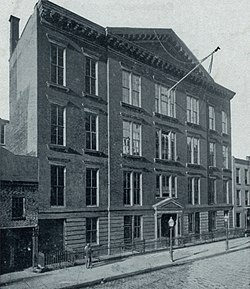Grammar School No. 35
| Grammar School No. 35 | |
|---|---|
 | |
| Address | |
 | |
60 W 13th Street , United States | |
| Coordinates | 40°44′10.529″N73°59′48.545″W/ 40.73625806°N 73.99681806°W |
| Information | |
| Type | Publichigh school |
| Established | 1847 |
| Campus type | Urban |
| Communities served | New York City |
Grammar School No. 35,also known as the "Thirteenth Street School" or "Ward School No. 35" was apublic schoolon 60 WestThirteenth StreetinManhattan,New York City.[1]It was known as one of the largest and most prestigious public schools for boys in New York City.[2]
History[edit]
Ward School No. 20 was built in 1847; in 1853, the ward schools in the city were renumbered, and the building became No. 35. The school had two departments: "Primary" and "Senior"; "Primary" was for boys only.[3]
Thomas Hunterbegan teaching at the school around 1850, when he arrived in the United States. He was made vice principal within four years, and was the school's principal from 1857 to 1869. He increased the student population from 300 to 1,000 students, and innovated a ban oncorporal punishment,an act that the Board of Education later instituted in all New York public schools.[1]Hunter's success at the school impressed William Wood of New York's Board of Education, who helped Hunter found what would becomeHunter College.[2]
The school building, bySixth Avenuein Manhattan, was a four-story brick building with about 30 classrooms, a playroom, and a basement, with a front and rear stairway as well as fire escapes. The building held about 1,000 students.[4][5]Alterations and additions to the building were made in 1861.[3]
From 1897 to 1905,DeWitt Clinton High Schooloccupied the school building.[6]This was later followed byJulia Richman High School,[7]andWashington Irving High Schooloccupied it around 1912.[4]
Notable alumni[edit]
Graduates of the school formed the Thomas Hunter Association, analumni association.[6]
- Frederick E. Crane,Chief Judge of theNew York Court of Appeals[8]
- Ashbel P. Fitch,U.S. Representative[1]
- Andrew Freedman,businessman[9]
- Charles Evans Hughes,Secretary of State and Chief Justice of the U.S. Supreme Court[8]
- Robert Stuart MacArthur,Baptist preacher[8]
- Charles Herbert Moore[10]
- J. Van Vechten Olcott,U.S. Representative[8]
- Charles Lane Poor,Astronomer[11]
- James Fitzgerald,New York State Senator and Justice of the New York Supreme Court[12]
- Charles L. Guy,New York State Senator and Justice of the New York Supreme Court[12]
- Robert Anderson Van Wyck,Chief Justice of the City Court of New York, Mayor of New York City[12]
See also[edit]
References[edit]
- ^abcRemington, David F. (2011).Ashbel P. Fitch: Champion of Old New York.Syracuse, New York:Syracuse University Press.pp.16–7.ISBN9780815651642.RetrievedDecember 25,2017.
- ^abFrom the Free Academy to CUNY: Illustrating Public Higher Education in New York City, 1847–1997.Bronx, New York:Fordham University Press.2000. p. 32.ISBN9780823220205.RetrievedDecember 25,2017.
- ^abDocuments of the Board of Education of the City of New York.New York, New York:New York Board of Education. 1912. pp. 17–8.RetrievedDecember 25,2017.
- ^abProceedings of the Board of Trustees.New York, New York: College of the City of New York. 1862. p. 88.RetrievedDecember 25,2017.
- ^Journal of the Board of Education of the City of New York.New York, New York: Board of Education of the City of New York. 1891. pp. 988–9.RetrievedDecember 25,2017.
- ^abKelley, Frank Bergen (1909).Historical Guide to the City of New York.New York, New York: Frederick A. Stokes Company. p. 107.RetrievedDecember 25,2017.
- ^High Schools of New York City: A Hand-book of Procedure & Personnel.New York, New York: High School Teachers Association of New York City. 1921. p. 143.RetrievedDecember 25,2017.
- ^abcd""Old Boys" Meet to Honor Dr. Hunter "(PDF).The New York Times.November 22, 1908.RetrievedDecember 25,2017.
- ^"Good Baseball Promised"(PDF).The New York Times.February 17, 1895.RetrievedDecember 25,2017.
- ^"Moore, Charles Herbert, 1840–1930. Papers of Charles Herbert Moore, 1894–1910: A Guide".The President and Fellows of Harvard College.Archived fromthe originalon July 3, 2018.RetrievedDecember 25,2017.
- ^"Who's who in America. v.4 1906-1907".HathiTrust.RetrievedDecember 22,2018.
- ^abc"Hunter's Old Boys At Annual Dinner".The New York Times.November 21, 1909.RetrievedAugust 6,2018.
